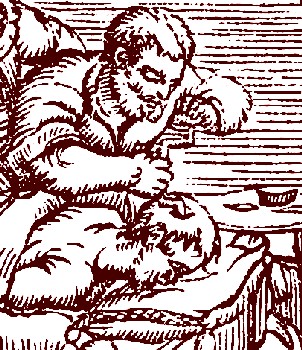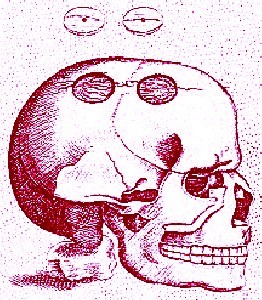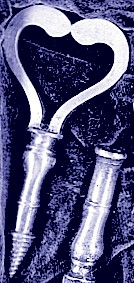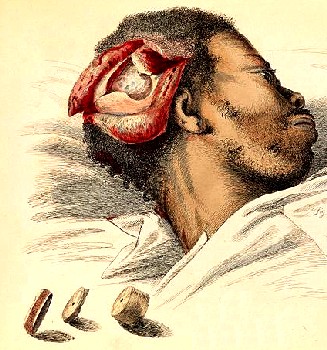
Head Surgery Page Menu: 1 2 3 4 5 6 7 8 9 10 11 12 13 14 Next>>
Head Surgery During the Golden Age of Piracy, Page 10
Trepanning Operation - Boring the Hole in the Skull
Once the teeth of the crown of the blade had started biting into the skull and the pin was removed, the difficult yet delicate work of boring through the bone began. The surgeon had a choice between using the brace-handled trepan and the T-handled trefine for the operation. Each surgeon had their own preference, although those sea surgeons who mention it generally seem to prefer the trefine. The one exception was sea surgeon John Atkins, who used both instruments - relying on the brace-handled trepan at the beginning of the operation and switching to the trefine (which he calls a traphine) once the pin was removed.1

Trepan Use Without Leaning, Chirurgiae Universalis Opus
Absolutum,
Giovanni Andrea della Croce (1573).
This is clearly not an accurate image, however. The
blade would be cutting into the brain as shown.
For boring, John Woodall explains that the brace-handled trepan is inconvenient to use because one of the surgeon's hands must be "turning it ever round for the better penetrating of the Cranium, [while] the other hand must be used to keep it steddy upon the affected part, and yet the upper part of the Instrument, must nevertheless, as of necessity rest upon the Surgeons brest, yea and the Surgeon must for that purpose order [place] his body in a fit posture" whereas with the trephine "the whole worke is performed by the two hands of the Surgeon onely, with farre more dexterity and quicker, then with the Trapan"2.
Fellow sea surgeon John Atkins doesn't mention using other body parts to steady or apply force to the tool; he simply suggests that the surgeon "Lean hard on the Top with the Left Hand, and then turn round with the other."3 Richard Wiseman likewise says, "When you have set on your Trepan, press upon it [the top] with your left hand, and turn it round with your right."4 This is usually how surgery is shown with a brace-handled trepan, as can be seen in the drawing at left.
There are differing opinions about how to approach the boring of the hole. In his usual no-nonsense style John Moyle tells his readers to "operate carefully, and with a

Trepanning a Skull with a Trefine , From the surgions mate,
By John
Woodall, p. 312 (1639)
steady hand, [until you bore] through the second Table [of the skull], but be diligent that you go not too far, least the teeth of your Traphine [trefine] tear the dura mater."5 Similarly, John Woodall advises "to proceed in piercing by the motion of the hand to and fro, untill hee have in all parts gon through the Cranium"6.
French surgical instructor Pierre Dionis recommended a more precise approach. Keep in mind that most surgeons divided the cranium into three layers at this time - the hard outside layer (outer table), the spongy middle layer (diploë) and the hard inside layer (inner table).
After the round ridge had been made in the skull and the pin was removed, Dionis explained "the Crown [of the trepan blade] is to be put into the Hole which it has made, and we keep turning of it till we come to the Diploe, which we discern by the reddish Saw-dust, and the Blood which very frequently proceeds from it."7
Once the surgeon had reached the middle layer, the surgeon was to remove the tapered blade and use a 'Piercer' [O] to thread the hole in the center of the round chip of bone which had previously guided the pin. This was done at this time because the bone was still being held secure by the inner table of the skull and 
Piercer & Quill, From A course of chirurgical
operations,
By
Pierre
Dionis (1708)
would not spin while the Piercer was being driven into it. (Details of the removal of the round, loose piece of bone from the trepanned hole will be discussed shortly.)
Following that, Dionis says to "probe the Circuit made by the Crown with the Quill P, cut like a Tooth-picker, to discover whether the Depth is equal, in order to lean the harder on that side of the Bone which is least cut.”8 He warns that the surgeon "is not to perform this precipitately [too hastily], for fear of hurting the Brain and the Membranes; nor ought he to be so slow, as to tire and render impatient, both the wounded Person and the Spectators; he ought to keep to the middle way, which depends on the Conduct and Dexterity of the Chirurgeon."9
1 See John Atkins, The Navy Surgeon, 1742, p. 85; 2 Woodall, p. 313-4; 3 Atkins, p. 85; 4 Richard Wiseman, Of Wounds, Severall Chirurgicall Treatises, 1676, p. 381; 5 John Moyle, The Sea Chirurgeon, 1693, p. 110; 6 John Woodall, the surgions mate, 1639, p. 315; 7,8 Pierre Dionis, A course of chirurgical operations: demonstrated in the royal garden at Paris. 2nd ed., p. 284; 9 Dionis, p. 285
Trepanning Operation - Cleaning and Cooling the Blade
“And in trepanning you must frequently remove the trepan, on account of the heat in the bone, and plunge it in cold water. For the trepan being heated by running round, and heating and drying the bone, burns it and makes a larger piece of bone around the sawing to drop off, than would otherwise do. And if you wish to saw at once down to the membrane, and then remove the bone, you must also, in like manner, frequently take out the trepan and dip it in cold water.” (Hippocrates, On Injuries of the Head, p. 465)

Bone Brush, From A course of chirurgical
operations, By Pierre Dionis (1708)
Only one of the period surgeons worry about the heat the trepan blade is generating; Richard Wiseman recommends occasionally 'brushing' the trepan "in doing of which it will cool."1 However, most of the surgeons do advise removing and cleaning the trepan blade for other reasons.
One of the most obvious is to clean the instrument. John Woodall recommends that the surgeon "sometimes take out the Instrument, and wipe the teeth thereof that it furre [become clogged] not too much, and thereby hinder the due penetration"2. Woodall later reiterates this point, advising the surgeon to "at the least twice or thrice in the time of his piercing the Cranium, take up & cleanse the teeth of the Instrument with a clout [piece of cloth] "3. French surgical instructor Pierre Dionis tells his students when they are trepanning to remove "the Crown to clear it of the Saw-Dust and Blood with the little Brush N… We several times draw out the Crown, in order to clean it."4 Wiseman simply suggests that "as it fouls, brush it"5. Sea surgeon John Atkins directs his readers "to remove the Instrument frequently, to clean it, and the Skull from Dust with a little Feather-Brush"6.

Elevator, From
Pierre
Dionis (1708)
The other reason for removing the trepan blade during the operation is to keep an eye on the depth to which the blade had cut. Woodall tells his surgeon's mates that by removing the blade and inspecting the work, "you easily may consider how farre you have penetrated, and what remaineth unpierced, that you may doe what is just in the work of penetration and no more."7 He expands upon this noting that "if the Artist observe not his intermissions, by forbearing now and then his piercing, as is said, and sometimes view his worke, and cleanse the teeth of the Instrument ere it be through, he is subject to goe too deepe, and wound the (Dura Mater) by the continued motion of his hand"8.
Dionis' explanation for checking the cut provides some insight into how the bone chip can be tested when the blade is removed. "In fine [to sum up], he [the surgeon] continues to raise up, and clean the Crown, and shake or move the piece with the Levitor [elevator] Q or with the Borer and to probe the Perforation as often as he thinks fit, till the Skull is intirely pierc’d through."9 Atkins likewise explains that "the best Caution we can take against [the crown touching the brain], is to remove the Instrument frequently... and to search the depth of the Bore with a Probe, and so the Surgeon may cut [the cranium] equally, by being informed at what Point to press hardest."10
1 Richard Wiseman, Of Wounds, Severall Chirurgicall Treatises, 1676, p. 381; 2 John Woodall, the surgions mate, 1639, p. 314; 3 Woodall, p. 316; 4 Pierre Dionis, A course of chirurgical operations: demonstrated in the royal garden at Paris. 2nd ed., p. 284; 5 Wiseman, p. 381; 6 John Atkins, The Navy Surgeon, 1742, p. 87; 7 Woodall, p. 314; 8 Woodall, p. 316; 9 Dionis, p. 284; 10 Atkins, p. 87
Trepanning Operation - Cutting Through The Bone
Sea surgeons John Woodall and John Moyle both give advice on how the surgeon will realize when to stop cutting through the skull when trepanning.

A Surgeon and Assistant Carefully Trepanning, From Traité
des opérations
de chirurgie by Rene Garengeot, (1731)
Moyle advises, "You will know when you are just through, by the piece [of bone in the center of the trepan] being loose."1 Woodall explains that the surgeon will recognize that he has finished cutting through the bone though diligent attention to "the tender observant motion of his owne hands, I meane he that pierceth shall sensibly feele when the bone is penetrated through on each part"2.
Woodall further orders the surgeon to remove the trepan blade during the operation
at the least twice or thrice in the time of his piercing [cutting into] ...as fearing whether it [the blade's toothed crown] have in all parts pierced through or not, or how much or in which part he is wanting for feare of going too deepe, otherwise he may kill his patient ere [before] he doth find or perceive hee is through, for a worke [that is] so seldome used, and the errours thereof being of so dangerous a consequent, the Artist [surgeon], although otherwise discreet, by omission, oblivion, or other improvidence be wanting in some observations.... it behooveth him to suspect himself and be cautious, for that a man can never be too wary in such a businesse3
Woodall's urging of caution on the part of the surgeon is palpable in this passage. In fact, it is due to this that several of the other surgeons writing on trepanning don't advise cutting all the way through the skull as we shall see.
As a side note, it is very interesting that the author of the first English book written specifically for sea surgeons says that the operation is seldom performed.
1 John Moyle, The Sea Chirurgeon, 1693, p. 110; 2 John Woodall, the surgions mate, 1639, p. 315; 3 Woodall, p. 316
Trepanning Operation - Removing the Bone Chip
The last step of the operation itself was to remove the round bone chip created by the hollow barrel of the trepanning tool. Surgeons mention three ways to remove the bone chip. The first method was taking it out inside of the barrel of the crown of the trepan blade, the

Trepanned Skull & Bone Chips, From Les Ouvres
des Johannes Scultetus (1598)
second was by spearing it using the hole made by the pin in the center of the bone chip and pulling it out and the third was by prying it out by using a tool to get under the side of the chip.
Woodall explains the first method, noting that once the surgeon feels the blade cut through the cranium, "drawing off his Instrument, hee shall find the peece of the Cranium so removed, fixed within the head of his Instrument as it is said."1 Moyle mentions this as one of two ways to remove the bone chip, with the chip coming out "within within the hollow of the Traphine head"2.
Both Richard Wiseman and Pierre Dionis advise against removing the bone chip this way. Wiseman pragmatically notes that leaving the bone chip "but slightly retained in some part" and removing it with another instrument is safer.3 His reasoning is that in order to bring the bone chip out in the head of the trepan blade, the surgeon must cut completely through the bottom of the skull which increases the risk of damaging the dura mater. Dionis is a bit more stern.
'Twould be a Fault in the Operation to bring off a piece of the Bone in the Cavity of the Crown [of the trepan] when we withdraw it, since we might then suspect that, having turn'd the Instrument more than we ought, its Teeth had hurt the Dura-Mater, tho' this Misfortune is what very rarely happen, unless it is foolishly and carelessly turn'd… But tho' the Fault of which we have been speaking is a very slight one, we are yet to avoid falling into it, in order to escaped the Censure of the Spectators.4

A Piercer In a Trepanning
Set
From the Wellcome
(late 18th/early 19th c.)
Dionis was an instructor, his operations were land-based so he would have had a much greater chance of having an audience. Sea surgeons were typically more concerned with speed, particularly during battle conditions and would not usually have had an audience other than the other men waiting for treatment in the dark confines of the orlop deck.
The second method for removing the bone chip was using a small, threaded hand tool. This is only mentioned by Dionis, who you will recall recommended that the surgeon thread the hole in the center of the bone chip after cutting through the first table of the skull. With the hole pre-threaded, "we make use of the Piercer O... in order, by its means, to raise up the piece of Bone; after it is perforated as deep as is necessary."5
The third method was to use an instrument to pry the bone chip out by its edge. Although Wiseman recognizes that the bone can be removed inside the hollow of the trepanning blade, he explains that "it will be safer to raise it up with your Levator [elevator], when it is so cut, that it is but slightly retained in some part."6 In this way, the edge of the smooth-bottomed elevator that is unlikely to damage the brain can be used to prise the bone out.
Although Moyle doesn't seem to share Wiseman's concern, he does note that when the bone chip doesn't come out in the trepanning tool's barrel "you must take it out with

Artist - Sir Charles Bell
Trepanned Skull & Different Types of Bone Chips, From the
Wellcome Collection (1821)
your Levatory [elevator], or other Instrument."7 In one of his accounts of a trepanning at sea, Moyle explained that after cutting "through the inner Table [of the skull], the piece of Bone was taken out with a small Levetor [elevator] and Forceps"8.
Two of the surgeons also note that the upper and lower parts of the bone chip may come out separately. Sea surgeon John Atkins explains, "Sometimes the Piece [of bone chip] comes out entire; and sometimes the two Tables [of the skull] are divided. This the Operator will perceive by the Instrument being a little bloody at touching the Diploe [the spongy, porous, bony tissue between the outer and inner layers of the cranium], and take away the first, when loose before he proceeds on the other"9.
Dionis also says that this can happen, with another note of concern about the opinion of the bystanders. "The first Table of the Bone may be raised before the second is cut, but tho' this is not the Operator's Fault, he is yet tacitly blam'd for it by those who see it; wherefore he is to do his best to avoid all Reproach, since a Chirurgeon never performs a considerable Operation without severe Censurers, which never forgive him any Fault."10
1 John Woodall, the surgions mate, 1639, p. 315; 2 John Moyle, The Sea Chirurgeon, 1693, p. 110; 3 Richard Wiseman, Of Wounds, Severall Chirurgicall Treatises, 1676, p. 381; 4 Pierre Dionis, A course of chirurgical operations: demonstrated in the royal garden at Paris. 2nd ed., p. 284; 6 Wiseman, p. 381; 7 Moyle, 1693, p. 110; 8 John Moyle, Memoirs: Of many Extraordinary Cures, 1708, p. 13; 8 John Atkins, The Navy Surgeon, 1742, p. 87; 10 Dionis, p. 285

